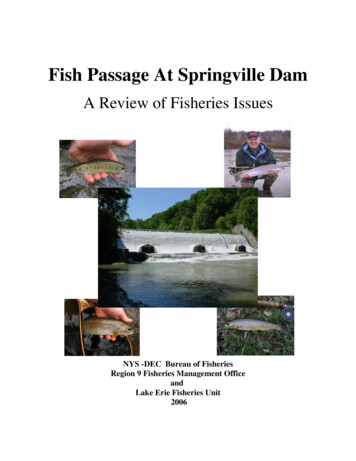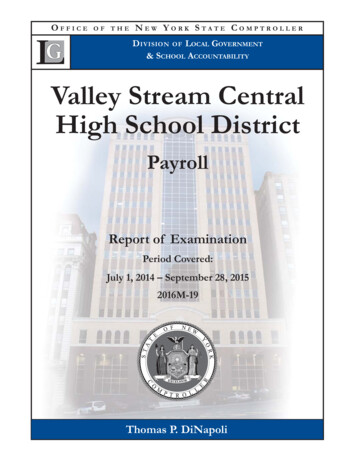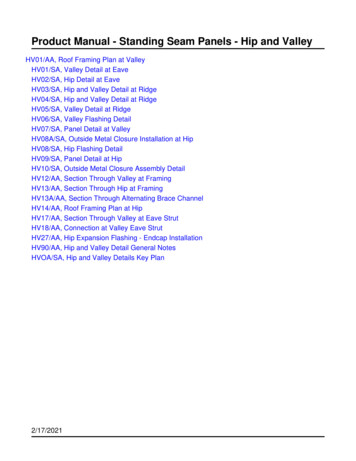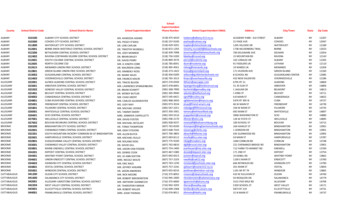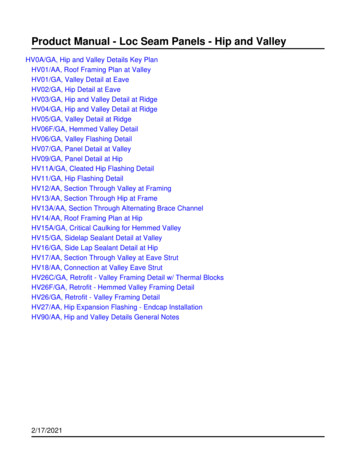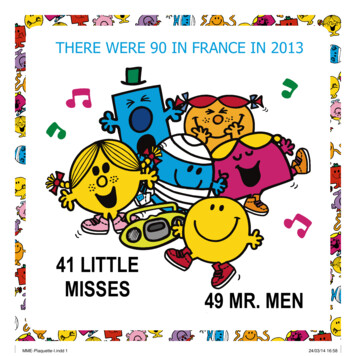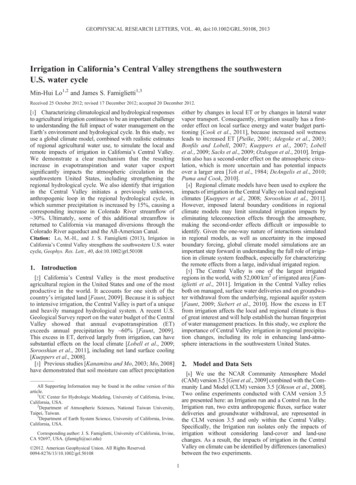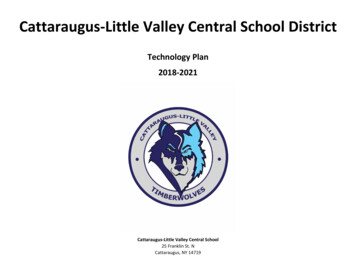
Transcription
Cattaraugus-Little Valley Central School DistrictTechnology Plan2018-2021Cattaraugus-Little Valley Central School25 Franklin St. NCattaraugus, NY 14719
ContentsMission: . 2District Contact:Richard Weinberg, Technology DirectorPhone: (716) 257-3483 x5029Fax: (716) 257-5108Email: rweinberg@clvschools.orgMission:The mission statement of the CLVCS system is to accept the responsibility for the education of all students in a caring and cooperative environment and toprepare students to be life-long learners who are independent, involved, and conscientious in a global community. We will provide the means for andexpectation that all our children will achieve their maximum academic potential while demonstrating social and emotional growth. This foundation willempower our youth to be lifelong learners and to become leaders into the 21st Century.District/School Background & DemographicsThe Cattaraugus-Little Valley Central School District came into existence when .Executive SummaryAt the District we are investing in hardware and software the students have access to. We are in a transition away from technology that is locked in rooms orcarts to technology students have 24/7 access to. Our students have the benefit of 24/7 access to information combined with personalized learning. The goal isnot one to one but three to one. Their BYOD, a district iPad and district work station(s) they can do larger cloud based projects on.Based on the Governors Symposium at UB September 17, 2014 we need to increase our upload and download from 40 Mbps to 100 Mbps this year and to 1Gbps per student by 2017. That road map has not been created let alone the trip planned out on it for our district. Fiber from AP to Backbone may be critical.WNYRIC has 2, 10 Gigabit connections to the backbone. That may be a bottle neck.
From a district perspective we plan a balanced approach. We will balance the required hardware/software, the end user support, Curriculum Integration,Marketing and Communication, Faculty Development, Financial Planning all to allow the students to be ridiculously successful and safe with the tools they haveaccess to.In this example, IT is a wheel with seven spokes not a ladder with five rungs.Introduction:Throughout history, schools have existed to prepare students to become competent and responsible citizens; in essence, productive members of the society towhich they are obligated to contribute. And as the world around us has changed, schools have had to adjust curricula and instructional methods to reflect theinherent differences. In this 21st century world, that has meant incorporating technology not just as an instructional aide, but as an integral part of theeducational experience.Today, students and teachers alike must be able to master technology as both skill and concept. Integrating technology into our school and community meansgiving students the knowledge to both use and understand its power and its pitfalls. Likewise, teachers and administrators must be capable of utilizingtechnology to enhance communication with parents and caregivers and collaboration with and among colleagues. The Cattaraugus-Little Valley Central SchoolDistrict strongly believes in the power of technology to transform the learning experiences and life trajectories of our students. As a high poverty, rural district,we depend on technology to provide an equal playing field for our students when it comes to preparing them for college and career readiness.As a committee, the board members, administrators, and teachers of this district, therefore, have undertaken the process of updating and renewing ourtechnology plan with the intent to provide a “living document” that will not just shape our technology growth and implementation over the next three years, butwill provide a theoretical and practical backdrop for technology-related decisions that highlights our desire to provide the best possible learning experiences forour students. After all, we fully understand that our students are not just future community members; they are our future.Stakeholders and Positions:Board of Education Rob ForsterJoel MerrillKirk ParmenterJoseph FrentzChris ShattuckBen StollJames WojdanSuperintendent Dr. Sharon Huff: District
Principals Kyle Yelich: High SchoolApril Preston: Middle SchoolMicah Oldham: Elementary SchoolDirector of Special Education Tina Maines: DistrictTechnology Department Rick Weinberg: Technology DirectorLori DeGroff: Technology SpecialistDale Baldwin: Technology SpecialistRob Miller: Technology IntegratorKonnie Minard: Technology SpecialistBusiness Office Sally Hadley: Business ExecutiveAnita Becker: Senior Account Clerk & School Tax CollectorHeather Ellis: Account Clerk TypistTechnology Committee – The district Technology Committee meets monthly to discuss our district technology needs. All staff members, students, andvisitors are always welcome. Anyone interested in attending or becoming a member of this committee, may contact Rick Weinberg at (716) 257-3483x5029 or Dale Baldwin at (716) 257-3483 x5028. Rick Weinberg: Technology DirectorJenny Conklin FrankDale Baldwin: Technology SpecialistLisa LaQuay: Library Media SpecialistLisa MusallChristopher MagudaMillington LockwoodSara CongdonBrooklyn Hill: Student
Vision for TechnologyThe Cattaraugus-Little Valley Central School District serves our community of learners by providing the resources and means through which our students canadapt to a changing world. Students of Cattaraugus-Little Valley Central School need to know problem solving techniques and need to possess the skills requiredto make sound decisions in a rapidly altering global society. To provide our student population with the most opportune educational experiences it is vital thattechnology encompass the learning environment. The district strives to incorporate cutting edge technology to prepare our students for the ever-evolvinginformation age. Developing and maintaining a constant system of staff development and growing infrastructure of technological support can only accomplishthis type of educational and technological philosophy. We believe that technology must be integrated into all facets of school life. Students must be preparedto use and responsibly apply technology in real life situations. Staff and students must be computer literate. We recognize that students must be taught theskills necessary to adapt to ever changing technological advances. The school is the center of the learning community. As such, the school will prepare itslearners to meet the technological demands of the workforce.The CLV Technology Plan serves to improve student learning through technology integration within the curricula setting. To ensure that students are preparedfor 21st Century technologies, it is critical that students be proficient in basic technology skills and also possesses the skills necessary to work independently andcollaboratively in research, in the workplace, and in their lifelong educational pursuits. Critical technology areas will be addressed within the CLV Community toensure that 21st technological needs are being addressed, including: Faculty technologyStudent technologyClassroom integrationLibrary technologyNetwork technologyInstructional designAssessmentsThe district anticipates that employing these technologies within the enhanced infrastructure created through the capital project will provide plentifulopportunities for personal and professional growth for both staff and students. Additionally, the district recognizes that continuous advancements within thetechnology arena will need to be reviewed and anticipated so that current trends are known and implemented; for, if these trends are recognized and integratedwithin the curricula setting, it is likely that staff and students will master 21st Century technological literacy skills.The Cattaraugus-Little Valley Central School District will use technology to provide the best educational and management tools for our students, teachers, staffand administration.These tools will provide strength to overall academic achievement. Educational technology will enhance the curriculum for already high achieving students,while providing a multidimensional approach to support remediation in reading, math and writing skills.Educational technology will help provide each student with the success needed to become a life-long learner with a positive self-image. The student will beprepared to accept the technological changes I the working world of the future.
Educational technology will enhance teacher and management productivity by increasing the ability to communicate with parents, students, colleagues, thebusiness community, and the world. The overall Technology Vision is to:1)2)3)4)5)6)7)Be specific in our educational goals and vision of learning through technologyProvide ongoing professional developmentAllow structural changes in the school day that promote learningMaintain a robust technical infrastructure and technical supportEnsure ongoing evaluation of our technology planHave connection speeds of 100 Mbps/student 2014 and 1 Gpbs 2017Build a student environment that supports the 3:1 device ratio per student.GoalsIn addition to the current broad use of technology, the CLV District has developed the following technology goals for the 2018-2021 school years. The goalswere developed as a means through which to ensure that administration, staff, students, and community members have opportune experiences encompassingtechnology use and integration for telecommunication, information and achievement.1) Offer faculty and staff targeted professional development around Common Core Learning Standards and opportunities for technology integration.a. Increase opportunities for teacher exposure to technologyb. Integrate technology into preparation, instruction and assessment.i. Pre-assessmentii. Planning/Researchingiii. Lesson Developmentiv. Lesson Implementationv. Assessment (when needed)c. Continue to evaluate teacher needs in areas of technology and technology integration.2) Promote student use of technology as a lifelong 21st century skill that encourages safe, legal, and responsible behavior.a. Establish recognition of courses and curriculum that promote student use of technology outside of school.b. Implement K-12 Responsible Use of Technology programc. Update, maintain, and evaluate users regarding acceptable use policy as needed.d. Enable teachers and parents to facilitate use of digital resources available to enhance student learning.3) Utilize technology to enhance communication throughout the greater school-community.a. Between staff and studentsb. Between staff and parents
c. Among staffd. With and within the communitye. With neighboring districts4) Provide for the tracking, storage, monitoring, and disposal of equipment and materials as needed.a. Monitor degree of usage of equipment by faculty/staffb. Track and monitor location of equipmentc. Investigate alternatives to outdated technology mediumsd. Investigate possibilities for alternative disposal/donation of outdated equipment5) Continue to offer faculty and students current technology resources.a. Monitor development of updates and new software and devicesb. Determine feasibility of providing 1:1 technology to studentsc. Continue to supplement current technological offerings with new equipment1) Students utilize technology to learn, create, communicate, collaborate, solve problems, and demonstrate understanding of the Common Core learningstandards.2) Teachers will grow away from only utilizing technology as a substitution for a classroom task to using technology with more modification andredefinition of original tasks (SAMR model – see appendix)3) Increase in student and staff awareness of available software and applications to enhance the curriculum.4) Provide continuing training to administrators, teachers, and staff in current software, applications, and current technology.5) Provide continuing technology integration in the classroom to prepare students for the workplace of today and the future.6) Ethical and responsible use of technology by students, teachers, administration, and staff.7) Upgrade existing hardware and software in classrooms, labs, and for students and teachers.8) Upgrade existing infrastructure to support student and staff use of technology.CR:1)2)3)4)5)Maintain, update, and add technology equipment and software to have access and utilize the most current and useful available technology.Dedicate money and time to ensure professional development opportunities and collaboration for students and staff.Establish an unwavering focus on innovative learning experiences for students and staff that match our district mission and vision.Organize and clarify responsibilities/funding for new and existing technologiesEnhance the relationship within the school, and between the school and community.Top 3 ChallengesOur focus is improved Internet availability and speed for all students. The challenges that are highest on our list are last mile connectivity for 20% of ourcommunity. We are rural. It may be more than a mile for many. Install next generation APs to allow wireless connectivity to be greater than 1 Gbps by 2017.
Work closely with our students, staff and community to allow the technology to help them all be ridiculously successful with learning and doing in school,college, and careers.I. Curriculuma. Curriculum IntegrationAt CLV our PreK-12 teachers and students have had 3 full years of 1:1 iPad integration in classrooms (7-12) as well as group iPad integration (PreK-6). Teachersalso have SMARTBoards in their classrooms, an in many cases several laptops or desktop computers are assigned to their rooms. All teachers have access tolaptop carts as well as computer labs. Technology is used throughout the district in a variety of ways and at a variety of different skill levels.While staff development will continue to be available for beginner use of our current technology, professional development on technology integration will beginto focus on using our technology for more than a substitute of the original curricular task. For example, the Notability application on the iPads replaces penciland paper note taking or worksheet completion. Based on the SAMR model, this is the lowest level of technology use. Professional development will helpteachers shift from merely substitution technology and onto augmentation, modification, and redefinition, where teaching improves along with studentlearning. By shifting from a teacher-centered classroom to an active learning student-centered environment, students will gain technology literacy skills that willimprove academic achievement.
Goal 1: Provide continuing training to administrators, teachers, and staff in current software, applications, and current technology and how to integrate thetechnology into the classroom to improve academic achievement.Actions needed to achieve goalStaff DevelopmentPerson(s) responsibleDate each action willbe completedOngoing throughouteach year of planProvide training sessions duringstaff development/superintendent days andsummer work daysIn-serviceCLV Technology Integrator,WNYRIC staff and/or CSLOstaffCABOCESOne on one training and/orsmall group training throughoutthe school year duringscheduled appointments,collaboration, or after schoolhours.Participate in CSLO and ModelSchools service with theWNYRIC to obtain and scheduletechnology training classesIn-serviceCLV Technology IntegratorOngoing throughouteach year of planCSLO & ModelSchoolsWNYRIC and/or CSLO Staff5 Days each yearParticipate in CA BOCES Coser517 Model Schools professionaldevelopment technologytraining classesCA BOCESCABOCES StaffOn-going throughoutthe each year of planSummer Technology workshopsfor all teachersIn-ServiceWNYRIC and/or CSLO StaffCABOCES StaffList of datesIndication of successISTETraining completed and logged inWinCapVerbal feedback from learnersImplementation in classroominstructionTraining completed and logged inWinCapVerbal feedback from learnersImplementation in classroominstructionNETS-T5a, b, c, dTraining completed and logged inWinCapVerbal feedback from learnersImplementation in classroominstructionTraining completed and logged inWinCapVerbal feedback from learnersImplementation in classroominstructionTraining completed and logged inWinCapVerbal feedback from learnersImplementation in classroominstructionNETS-T5a, b, c, dNETS-T5a, b, c, dNETS-T5a, b, c, dNETS-T5a, b, c, dGoal 2: Provide students with more opportunities to demonstrate creative thinking, construct knowledge, and develop innovative products and processesusing technology.Actions needed to achieve goalStaff DevelopmentPerson(s) responsibleEstablish a “Maker’s Club” forstudents to attend after schoolNoneTechnology integrator,district staffContinue to offer MinecraftEDUclub to students in grades 3-6NoneTechnology integratorDate each action willbe completedBy the end of the 16-17school yearOn-going throughouteach year of planIndication of successClub hold regular meetings and has aconsistent attendance of at least 5studentsClub hold regular meetings and has aconsistent attendance of at least 5studentsISTENETS-S1a, b, c,2a, d4bNETS-S1a, b,c
Train teachers in creativesoftware/applications or othertechnologies to use inclassroomsEstablish a Lego RoboticsLeague afterschool clubHummingbird Kittraining, GoogleSketchup training,Aurasma training,etc.CA BOCESTechnology Integrator,WNYRIC and/or CSLO staffCABOCES StaffOn-going throughouteach year of planTechnology integrator,District staffBy the end of 17-18school yearTraining completed and logged inWinCapVerbal Feedback from learnersImplementation in classroominstructionClub holds regular meetings and hasa consistent attendance of at least 5studentsNETS-T5a, b, c, dNETS-S1a, b, c2a, d4bGoal 3: Expand the use of Web 2.0 technologies including teacher/student blogs, wikis, websites, collaboration tools, and social networking sites to extendlearning beyond the physical border of the district.Actions needed to achieve goalStaff DevelopmentModel the use of blogs, wikis,classroom websites,collaboration tools, and socialnetworking sitesIn-service for kshops, orscheduledappointmentsIn-service for kshops, orscheduledappointmentsTeachers use Web 2.0applications asteaching/learning toolsPerson(s) responsibleTechnology Integrator,AdministrationDate each action willbe completedOn-going throughouteach year of planTechnology Integrator,District staffOn-going throughouteach year of planStaff DevelopmentStudent Technology Help Deskgroup created for students tohelp peers, teachers, and staffwith technology needs. (Grades7-12)PD on newtechnologies – CABOCES, CSLOModel SchoolsISTETeachers, administration, and staffuse Web 2.0 tools to collaborate witheach other and with their studentsNETS-T1a, c, d2a, b3b4a, c5a, bStudents are using Web 2.0 tools asa means to collaborate, create, andshare their ideas and projects.Students continue the engagementoutside of classroom.NETS-T1a, c, d2a, b3b4a, c5a, bNETS-S2a, b, c, d5a, b, cGoal 4: Students demonstrate a sound understanding of technology concepts, systems, and operationsActions needed to achieve goalIndication of successPerson(s) responsibleTechnology Integrator,District StaffDate each action willbe completedBy end of 18-19 schoolyearIndication of successThe Technology Help Desk group isup and running with at least 5members. Students haveappointments with “customers” andare able to solve/close their case.ISTENETS-S45b, d6a, b, c, d
Students in grades 7 and 8complete courses: Technology 7and Computer Studies &InstructionPD on newtechnologies – CABOCES, CSLOModel SchoolsTechnology IntegratorOn-going throughouteach year of planStudents successfully earn credit foreach ½ year course.Students complete each project witha passing grade.Students are transferring the skillsthey learned throughout theircoursework in other classes.NETS-T1a, b2a3aNETS-S6a, b, c, dGoal 5: Build a culture that promotes and models responsible digital citizenship that includes; digital footprint, intellectual property rights, accessing andevaluating Internet information, and personal safety.Actions needed to achieve goalStaff DevelopmentPerson(s) responsibleDate each action willbe completedYearlyStudents in grades PreK-12attend a 30 minute session onInternet safety, social mediaand cyberbullying, andintellectual property rights.Librarians and teachersdemonstrate the proper way tocite online sources.Continue to implement areporting tool for students toanonymously inform the districtof Internet safety issues orbullying incidents (DASA)As neededTechnology Integrator,School Psychologist,administrationAs neededLibrarian, PreK-12 TeachersOn-going throughouteach year of planTeacher, parent,and student,awarenessBuilding administrationOn-going throughouteach year of planIndication of successISTEStudents demonstrate properInternet etiquette, report incidents,and cite online sources both duringand after school hours.NETS-S5a, b, c, dStudents cite pictures, songs,websites, videos, and research theyfind on the InternetThe number of incidents reported bystudents and/or staff.NETS-S5a, b, c, dNETS-S5a, b, c, dCR – PROFESSSIONAL DEVELOPMENTPROFESSIONAL STAFF DEVELOPMENT GUIDING ASSUMPTIONSTo help guide us toward successful professional staff development, we have included some guiding assumptions of staff development. The National StaffDevelopment Council and the New York State Staff Development Council offer the following characteristics which may support and sustain our community ofadult learners.1. Incorporation of available knowledge basis: Current research findings need to be integrated into the educational process.
2. Designs built on principles of adult learning and change process: Effective educational practices for students and adults may be derived from researchfindings.3. Experimentation and risk taking: people acquire and retain new skills and knowledge through a growth process more effectively than through a processwhich emphasizes correction.4. Collegiality and collaboration: commitment to implement planned change is built through collaboration and open communication.5. appropriate participant involvement in goal setting, implementation evaluation and decision making: needs identified by various constituent groupsand individuals may be the basis for designing staff development programs and activities.6. Time to work on staff development and assimilate new learning: solutions to complex problems require systematic decision-making processes.7. Leadership and administrative commitment: change is a process – not an event. Since implementation of education programs takes from 2-5 years, itrequires continual support at all levels.8. Integration of individual goals, school and district goals as well as State and Federal standards of technology competencies: the nature of the workingenvironment must be considered in designing staff development support activities.9. Formal placement of the program within the philosophy and organizational structure of the school and district: efficient and effective investment indeveloping the districts human resources yields dividends in accomplishing district goals.Professional Development PlanOn or before the 15th calendar day after the first student attendance day of each school year, each employee will submit to the unit members building Principalan individual professional growth plan identifying the professional growth activities the employee will undertake to improve the employee’s knowledge ofcurriculum taught by the employee, the employee’s instructional skills and/or the employee’s interpersonal skills. The plan will also explain how the activitiesmay improve the employee’s professional abilities and may positively affect student achievement. The teacher and the Building Principal will thereafter meet todiscuss the plan and the Principal may make suggestions to improve the plan, but the Principal may not dictate the content of the plan. The teacher may modifythe plan at any time thereafter, but must inform the Principal in writing of any changes to the plan. A returning teacher may submit a professional growth planfor summer activities by July 1. Such activities shall be considered as meeting the professional development responsibilities for the next school year.On or before June 30 of each school year, each employee will provide a written explanation to the Principal of what professional growth activities the teacherengaged in since the end of the last school year. The explanation will also include an explanation of how the activities impacted the employee’s professionalabilities and/or student achievement and an approximation of the number of hours the teacher was engaged in such activities.CLV Professional Growth ActivitiesHigh quality professional development is essential to creating schools in which all staff members are learners who continually improve their performance.Professional development not only includes high-quality ongoing training programs with follow-up and support, but also may include growth promoting jobembedded, process such as those listed below:Video review, CD-ROM or Online TutorialsRegional/National conferences/workshopsSite visitations
Leadership role in a professional organizationGrade level/discipline study groups: two or more teachers research a topic relevant to their areaAction research: raising questions about how to improve practice, studying the literature and research related to their question(s), and selecting an approachthat might result in improving current practice.Reflective logs: keeping a log of specific Practices, within a topic, to determine what is important, working, the strengths among implications.‘Best Practice’ Research: investigate the best practices in a specific area.Assessment Literacy: becoming proficient in the area of assessmentCase studies: using carefully chosen, real-world examples of teaching to serve as springboards for discussions among small groups of teachers.Coaching: teachers taking and acting with a goal of continuously improving their teaching practice. Being critical listener/observer, ask questions, makesuggestions that help a teacher grow and reflect.Curriculum development: developing curriculum maps and webbingExamining student work: to ensure that what students learn is aligned with standardsWorkshop attendanceObservation of other teachersPortfolioPeer reviewTraining to be a mentor teacher for peer reviewContent area study and/or exploration, travel, or other school visitationsSUPPORT LETTER OF PROFESSIONAL DEVELOPMENT – TECHNOLOGY INTEGRATION SPECIALISTTo whom it may concern,The Technology Integration Specialist (TIS) has the privilege to facilitate the use of technology to benefit student achievement. The TIS focuses on the staffdevelopment needs of the faculty in the area of technology integration into the instructional program of the district. Some of the specific duties relating toProfessional Development are listed. Assists individual teachers in their classrooms on the full integration of technology into their instructional plan. This includes lesion planning, problemsolving, modeling of instructional strategies, and instructional coaching related to technology.Provides faculty in-service training
Disseminates research and literature to faculty on instructional technologyAssist teachers through the ‘check points’ established by the Technology Training Committee.Remains current in the field by reading research and literature, attending conferences and workshops and networking.Assists Curriculum Coordinator. Conducts annual staff development needs assessment related to instructional technology and implements a technologystaff development plan for Instruction with help by the Technology Coordinator and the SuperintendentServes on the district technology committeeWorks with administrative and instructional teams to effectively infuse technology into the instructional programPlanning and overseeing operation of summer computer camps.The enthusiasm of the staff, students and community has generated positive momentum in the area of technology integration at CLV. The “21st Century Tools”and skills are being utilized with proven teaching methods to prepare students to be life-long learners who are independent, involved, and conscientious citizensin a global community.SIGN-HERETECHNOLOGY STANDARDS – ISTE NATIONAL EDUCATIONAL TECHNOLOGY STANDARDS FOR STUDENTSCLV has adopted the ISTE National Educational Technology Standards for Students and has implemented curriculum andtechnology classes K-12 that ensures our students master the use of technology and become technology literate.NETS for StudentsTechnology Foundation Standards for All StudentsThe technology foundation standards for students are divided into six broad categories. Standards within each category are to be introduced, reinforced, andmastered by students. These categories provide a framework for linking performance indicators within the Profiles for Technology Literate Students to thestandards. Teachers can use these standards and profiles as guidelines for planning technology-based activities in which students achieve success in learning,communication, and life skills.Technology Foundation Standards for Students1) Basic operations and concepts Students demonstrate a sound understanding of the nature and operation of technology systems Students are proficient in the use of technology2)
visitors are always welcome. Anyone interested in attending or becoming a member of this committee, may contact Rick Weinberg at (716) 257-3483 x5029 or Dale Baldwin at (716) 257-3483 x5028. Rick Weinberg: Technology Director Jenny Conklin Frank Dale Baldwin: Technology Specialist Lisa LaQuay: Library Media Specialist
